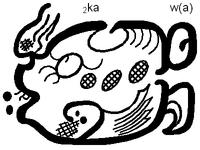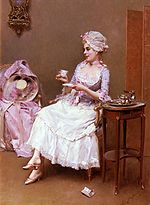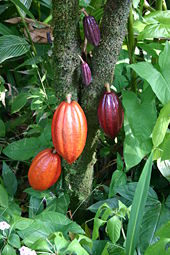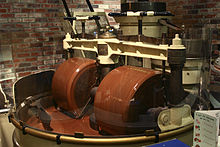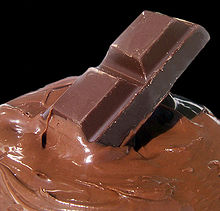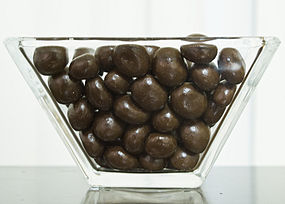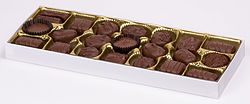- Chocolate
-
 Chocolate most commonly comes in dark, milk, and white varieties, with cocoa solids contributing to the brown coloration.
Chocolate most commonly comes in dark, milk, and white varieties, with cocoa solids contributing to the brown coloration.
Chocolate
 i/ˈtʃɒkᵊlɨt/ is a raw or processed food produced from the seed of the tropical Theobroma cacao tree. Cacao has been cultivated for at least three millennia in Mexico, Central and South America. Its earliest documented use is around 1100 BC. The majority of the Mesoamerican people made chocolate beverages, including the Aztecs, who made it into a beverage known as xocolātl, a Nahuatl word meaning "bitter water". The seeds of the cacao tree have an intense bitter taste, and must be fermented to develop the flavor.
i/ˈtʃɒkᵊlɨt/ is a raw or processed food produced from the seed of the tropical Theobroma cacao tree. Cacao has been cultivated for at least three millennia in Mexico, Central and South America. Its earliest documented use is around 1100 BC. The majority of the Mesoamerican people made chocolate beverages, including the Aztecs, who made it into a beverage known as xocolātl, a Nahuatl word meaning "bitter water". The seeds of the cacao tree have an intense bitter taste, and must be fermented to develop the flavor.After fermentation, the beans are dried, then cleaned, and then roasted, and the shell is removed to produce cacao nibs. The nibs are then ground to cocoa mass, pure chocolate in rough form. Because this cocoa mass usually is liquefied then molded with or without other ingredients, it is called chocolate liquor. The liquor also may be processed into two components: cocoa solids and cocoa butter. Unsweetened baking chocolate (bitter chocolate) contains primarily cocoa solids and cocoa butter in varying proportions. Much of the chocolate consumed today is in the form of sweet chocolate, combining cocoa solids, cocoa butter or other fat, and sugar. Milk chocolate is sweet chocolate that additionally contains milk powder or condensed milk. White chocolate contains cocoa butter, sugar, and milk but no cocoa solids.
Cocoa solids contain alkaloids such as theobromine and phenethylamine, which have physiological effects on the body. It has been linked to serotonin levels in the brain. Some research found that chocolate, eaten in moderation, can lower blood pressure.[1] The presence of theobromine renders chocolate toxic to some animals,[2] especially dogs and cats.
Chocolate has become one of the most popular food types and flavors in the world. Gifts of chocolate molded into different shapes have become traditional on certain holidays: chocolate bunnies and eggs are popular on Easter, chocolate coins on Hanukkah, Santa Claus and other holiday symbols on Christmas, and chocolate hearts or chocolate in heart-shaped boxes on Valentine's Day. Chocolate is also used in cold and hot beverages, to produce chocolate milk and hot chocolate. Around three quarters of the world's cacao bean production takes place in West Africa.
Theobroma cacao, native to Mexico, Central and South America, has been cultivated for at least three millennia in that region. Cocoa mass was used originally in Mesoamerica both as a beverage and as an ingredient in foods.
Chocolate played a special role in both Maya and Aztec royal and religious events. Priests presented cacao seeds as offerings to the gods and served chocolate drinks during sacred ceremonies. All of the areas that were conquered by the Aztecs that grew cacao beans were ordered to pay them as a tax, or as the Aztecs called it, a "tribute".[3]
The Europeans sweetened and fattened it by adding refined sugar and milk, two ingredients unknown to the Mexicans. By contrast, the Europeans never infused it into their general diet, but have compartmentalized its use to sweets and desserts. In the 19th century, Briton John Cadbury developed an emulsification process to make solid chocolate creating the modern chocolate bar. Although cocoa is originally from the Americas, today Western Africa produces almost two-thirds of the world's cocoa, with Côte d'Ivoire growing almost half of it.
Contents
Etymology
The word "chocolate" entered the English language from Spanish.[4] How the word came into Spanish is less certain, and there are multiple competing explanations. Perhaps the most cited explanation is that "chocolate" comes from Nahuatl, the language of the Aztecs, from the word chocolātl, which many sources derived from xocolātl [ʃokolaːtɬ], from xococ 'sour' or 'bitter', and ātl 'water' or 'drink'.[4] However, as William Bright noted[5] the word "chocolatl" does not occur in central Mexican colonial sources, making this an unlikely derivation. Santamaria[6] gives a derivation from the Yucatec Maya word "chokol" meaning hot, and the Nahuatl "atl" meaning water. Sophie and Michael D. Coe agree with this etymology. Pointing to various sources dating from the time period of the Spanish conquest, they identify cacahuatl ("cacao water") as the original Nahuatl word for the cold beverage consumed by the Aztecs. Noting that using a word with caca in it to describe a thick, brown beverage would not have gone over well with most speakers of Spanish due to the fact that caca means faeces in Spanish, the Coes suggest that the Spanish colonisers combined the Nahuatl atl with the Yucatec Maya chocol, for unlike the Aztec, the Maya tended to drink chocolate heated. The Spanish preferred the warm Mayan preparation of the beverage to the cold Aztec one, and so the colonisers substituted chocol in place of the culturally unacceptable caca.[7] More recently, Dakin and Wichmann derive it from another Nahuatl term, "chicolatl" from eastern Nahuatl, meaning "beaten drink". They derive this term from the word for the frothing stick, "chicoli".[8] However, the Coes write that xicalli referred to the gourd out of which the beverage was consumed and that the use of a frothing stick (known as a molinollo) was a product of creolisation between the Spanish and Aztec; the original frothing method used by the indigenous people was simply pouring the drink from a height into another vessel.[7]
History
Mesoamerica history
Chocolate has been used as a drink for nearly all of its history. The earliest record of using chocolate dates back before the Olmec. In November 2007, archaeologists reported finding evidence of the oldest known cultivation and use of cacao at a site in Puerto Escondido, Honduras, dating from about 1100 to 1400 BC.[9] The residues found and the kind of vessel they were found in indicate the initial use of cacao was not simply as a beverage, but the white pulp around the cacao beans was likely used as a source of fermentable sugars for an alcoholic drink.[9] The Maya civilization grew cacao trees in their backyards,[10] and used the cacao seeds it produced to make a frothy, bitter drink.[11] Documents in Maya hieroglyphs stated chocolate was used for ceremonial purposes, in addition to everyday life.[12] The chocolate residue found in an early ancient Maya pot in Río Azul, Guatemala, suggests the Maya were drinking chocolate around 400 AD.
The sweet chocolate residue found in jars from the site of Puerto Escondido in Honduras from around 1100 BC is the earliest found evidence of the use of cacao to date.[13] An early Classic (460-480 AD) period Mayan tomb from the site of Rio Azul, Guatemala, had vessels with the Maya glyph for cacao on them with residue of a chocolate drink.[14] The Maya are generally given credit for creating the first modern chocolate beverage over 2,000 years ago, despite the fact that the beverage would undergo many more changes in Europe.[15]
By the 15th century, the Aztecs gained control of a large part of Mesoamerica, and adopted cacao into their culture. They associated chocolate with Xochiquetzal, the goddess of fertility,[16] and often used chocolate beverages as sacred offerings.[14] The Aztec adaptation of the drink was a bitter, frothy, spicy drink called xocolatl, made much the same way as the Mayan chocolate drinks. It was often seasoned with vanilla, chile pepper, and achiote, and was believed to fight fatigue, which is probably attributable to the theobromine content, a mood enhancer. Because cacao would not grow in the dry central Mexican highlands and had to be imported, chocolate was an important luxury good throughout the Aztec empire, and cocoa beans were often used as currency.[17] For example, the Aztecs used a system in which one turkey cost one hundred cacao beans and one fresh avocado was worth three beans.[18] South American and European cultures have used cocoa to treat diarrhea for hundreds of years.[19] All of the areas ruled by the Aztecs were ordered to pay a tax, leading those that grew the beans to offer cacao seeds as tribute.[20]
European adaptation
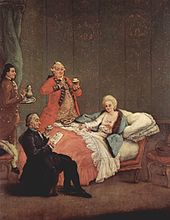 Chocolate soon became a fashionable drink of the nobility after the discovery of the Americas. The morning chocolate by Pietro Longhi; Venice, 1775-1780.
Chocolate soon became a fashionable drink of the nobility after the discovery of the Americas. The morning chocolate by Pietro Longhi; Venice, 1775-1780.
The first European contact with chocolate came when Montezuma (then tlatoani of Tenochtitlan) introduced Hernán Cortés, a Spanish conquistador, to xocolatl in the 16th century.[14] Antonio de Solís, Philip IV's official Chronicler of the Indies, described Montezuma customarily taking a chocolate beverage after meals, as part of a sumptuous daily ritual:
He had Cups of Gold, and Salvers of the same; and sometimes he drank out of Cocoas [i.e., coconut shells], and natural Shells, very richly set with Jewels.[...] When he had done eating, he usually took a Kind of Chocolate, made after the Manner of the Country, that is, the Substance of the Nut beat up with the Mill till the Cup was filled more with Froth than with Liquor; after which he used to smoak Tobacco perfum'd with liquid Amber.[21]
Jose de Acosta, a Spanish Jesuit missionary who lived in Peru and then Mexico in the later 16th century, wrote of it:
Loathsome to such as are not acquainted with it, having a scum or froth that is very unpleasant taste. Yet it is a drink very much esteemed among the Indians, where with they feast noble men who pass through their country. The Spaniards, both men and women that are accustomed to the country are very greedy of this Chocolate. They say they make diverse sorts of it, some hot, some cold, and some temperate, and put therein much of that "chili"; yea, they make paste thereof, the which they say is good for the stomach and against the catarrh.[22]
The first recorded shipment of chocolate to Europe for commercial purposes was in a shipment from Veracruz to Sevilla in 1585.[16] It was still served as a beverage, but the Europeans added cane sugar to counteract the natural bitterness and removed the chili pepper while retaining the vanilla, in addition they added cinnamon as well as other spices.[14]
What the Spaniards then called "chocolatl" was said to be a beverage consisting of a chocolate base flavored with vanilla and other spices that was served cold.[23][24] Montezuma's court reportedly drank about 2,000 cups of xocolatl per day, 50 of which were consumed by Montezuma himself.
Until the 16th century, no European had ever heard of the popular drink from the Central and South American peoples.[25] It was not until the Spanish conquest of the Aztecs that chocolate could be imported to Europe. In Spain, it quickly became a court favorite. In a century it had spread and become popular throughout the European continent.[25] To keep up with the high demand for this new drink, Spanish armies began enslaving Mesoamericans to produce cacao.[26] Even with cacao harvesting becoming a regular business, only royalty and the well-connected could afford to drink this expensive import.[27] Before long, the Spanish began growing cacao beans on plantations, and using an African workforce to help manage them.[28] The situation was different in England. Put simply, anyone with money could buy it.[29] The first chocolate house opened in London in 1657.[29] In 1689, noted physician and collector Hans Sloane developed a milk chocolate drink in Jamaica which was initially used by apothecaries, but later sold to the Cadbury brothers in 1897.[30]
Chocolate in its solid form was invented in 1847. Joseph Fry and Son discovered a way to mix some of the cocoa butter back into the Dutched chocolate, and added sugar, creating a paste that could be moulded. The result was the first modern chocolate bar.
For hundreds of years, the chocolate-making process remained unchanged. When the Industrial Revolution arrived, many changes occurred that brought about the food today in its modern form. A Dutch family's (van Houten) inventions made mass production of shiny, tasty chocolate bars and related products possible. In the 18th century, mechanical mills were created that squeezed out cocoa butter, which in turn helped to create hard, durable chocolate.[31] But, it was not until the arrival of the Industrial Revolution that these mills were put to bigger use. Not long after the revolution cooled down, companies began advertising this new invention to sell many of the chocolate treats we see today.[32] When new machines were produced, people began experiencing and consuming chocolate worldwide.[33]
At the end of the 18th century, the first form of solid chocolate was invented in Turin by Doret. This chocolate was sold in large quantities from 1826 by Pierre Paul Caffarel. In 1819, F. L. Cailler opened the first Swiss chocolate factory. In 1828, Dutchman Coenraad Johannes van Houten patented a method for extracting the fat from cocoa beans and making powdered cocoa and cocoa butter. Van Houten also developed the "so-called" Dutch process of treating chocolate with alkali to remove the bitter taste. This made it possible to form the modern chocolate bar. It is believed that the English company, J. S. Fry & Sons made the first chocolate for eating in 1847, followed in 1849 by the Cadbury brothers.
Daniel Peter, a Swiss candle maker, joined his father-in-law's chocolate business. In 1867, he began experimenting with milk as an ingredient. He brought his new product, milk chocolate, to market in 1875. He was assisted in removing the water content from the milk to prevent mildewing by a neighbour, a baby food manufacturer named Henri Nestlé. Rodolphe Lindt invented the process called conching, which involves heating and grinding the chocolate solids very finely to ensure that the liquid is evenly blended. This enabled Milton Hershey to make chocolate even more popular by mass producing affordable chocolate bars.
Types
Several types of chocolate can be distinguished. Pure, unsweetened chocolate contains primarily cocoa solids and cocoa butter in varying proportions. Much of the chocolate consumed today is in the form of sweet chocolate, combining chocolate with sugar. Milk chocolate is sweet chocolate that additionally contains milk powder or condensed milk. In the U.K. and Ireland milk chocolate must contain a minimum of 20% total dry cocoa solids; in the rest of the European Union the minimum is 25%.[34] "White chocolate" contains cocoa butter, sugar, and milk, but no cocoa solids. Chocolate contains alkaloids such as theobromine and phenethylamine, which have some physiological effects in humans, but the presence of theobromine renders it toxic to some animals, such as dogs and cats.[2] It has been linked to serotonin levels in the brain. Dark chocolate has been promoted[who?] for unproven health benefits, as it seems to possess substantial amount of antioxidants that reduce the formation of free radicals.
White chocolate is formed from a mixture of sugar, cocoa butter and milk solids. Although its texture is similar to milk and dark chocolate, it does not contain any cocoa solids. Because of this, many countries do not consider white chocolate as chocolate at all.[35] Although first introduced by Hebert Candies in 1955, Mars, Incorporated was the first to produce white chocolate within the United States. Because it does not contain any cocoa solids, white chocolate does not contain any theobromine, meaning it can be consumed by animals. It is usually not used for cooking.
Dark chocolate is produced by adding fat and sugar to the cacao mixture. The U.S. Food and Drug Administration calls this "sweet chocolate", and requires a 15% concentration of chocolate liquor. European rules specify a minimum of 35% cocoa solids.[34] Dark chocolate, with its high cocoa content, is a rich source of epicatechin and gallic acid, which are thought to possess cardioprotective properties. Dark chocolate has also been said to reduce the possibility of a heart attack when consumed regularly in small amounts.[36] Semisweet chocolate is a dark chocolate with a low sugar content. Bittersweet chocolate is chocolate liquor to which some sugar (typically a third), more cocoa butter, vanilla and sometimes lecithin have been added. It has less sugar and more liquor than semisweet chocolate, but the two are interchangeable in baking.
Unsweetened chocolate is pure chocolate liquor, also known as bitter or baking chocolate. It is unadulterated chocolate: the pure, ground, roasted chocolate beans impart a strong, deep chocolate flavor.
Raw chocolate, often referred to as raw cacao, is always dark and a minimum of 75% cacao. Because the act of processing results in the loss of certain vitamins and minerals (such as magnesium), some consider raw cacao to be a more nutritious form of chocolate.[37]
Some people who purchase chocolate off the store shelf can be disappointed when they see whitish spots on the dark chocolate part. This is called chocolate bloom and is not an indication of chocolate gone bad. Instead, this is just an indication that sugar and/or fat has separated due to poor storage.
Production
Roughly two-thirds of the entire world's cocoa is produced in West Africa, with 43% sourced from Côte d'Ivoire,[38] where child labor is a common practice to obtain the product.[39][40] According to the World Cocoa Foundation, some 50 million people around the world depend on cocoa as a source of livelihood.[41] In the UK, most chocolatiers purchase their chocolate from them, to melt, mold and package to their own design.[42] Despite some disagreement in the EU about the definition,[clarification needed] chocolate is any product made primarily of cocoa solids and cocoa butter.
Production costs can be decreased by reducing cocoa solid content or by substituting cocoa butter with another fat. Cocoa growers object to allowing the resulting food to be called "chocolate", due to the risk of lower demand for their crops.[41] The sequencing in 2010 of genome of the cacao tree may allow yields to be improved.[43]
There are two main jobs associated with creating chocolate candy, chocolate makers and chocolatiers. Chocolate makers use harvested cacao beans and other ingredients to produce couverture chocolate (covering). Chocolatiers use the finished couverture to make chocolate candies (bars, truffles, etc.).[44]
Cacao varieties
Chocolate is made from cocoa beans, the dried and partially fermented seeds of the cacao tree (Theobroma cacao), a small (4–8 m (or 15–26 ft) tall) evergreen tree native to the deep tropical region of the Americas. Recent genetic studies suggest that the most common genotype of the plant originated in the Amazon basin and was gradually transported by humans throughout South and Central America. Early forms of another genotype have also been found in what is now Venezuela. The scientific name, Theobroma, means "food of the gods".[45] The fruit, called a cacao pod, is ovoid, 15–30 cm (or 6–12 in) long and 8–10 cm (3–4 in) wide, ripening yellow to orange, and weighs about 500 g (1 lb) when ripe.
Cacao trees are small, understory trees that need rich, well-drained soils. They naturally grow within 20 degrees of either side of the equator because they need about 2000 millimeters of rainfall a year, and temperatures in the range of 21 to 32 °C. Cacao trees cannot tolerate a temperature lower than 15 °C (59 °F).[46]
The three main varieties of cacao beans used in chocolate are criollo, forastero, and trinitario.
Representing only five percent of all cocoa beans grown,[47] criollo is the rarest and most expensive cocoa on the market, and is native to Central America, the Caribbean islands and the northern tier of South American states.[48] There is some dispute about the genetic purity of cocoas sold today as criollo, as most populations have been exposed to the genetic influence of other varieties. Criollos are particularly difficult to grow, as they are vulnerable to a variety of environmental threats and produce low yields of cocoa per tree. The flavor of criollo is described as delicate yet complex, low in classic chocolate flavor, but rich in "secondary" notes of long duration.[49]
The most commonly grown bean is forastero,[47] a large group of wild and cultivated cacaos, most likely native to the Amazon basin. The African cocoa crop is entirely of the forastero variety. They are significantly hardier and of higher yield than criollo. The source of most chocolate marketed,[47] forastero cocoas are typically strong in classic "chocolate" flavor, but have a short duration and are unsupported by secondary flavors, producing "quite bland" chocolate.[47]
Trinitario is a natural hybrid of criollo and forastero. Trinitario originated in Trinidad after an introduction of forastero to the local criollo crop. Nearly all cacao produced over the past five decades is of the forastero or lower-grade trinitario varieties.[50]
Processing
Video of cacao beans being ground and mixed with other ingredients to make chocolate at a Mayordomo store in Oaxaca, Mexico
Cacao pods are harvested by cutting the pods from the tree using a machete, or by knocking them off the tree using a stick. The beans with their surrounding pulp are removed from the pods and placed in piles or bins, allowing access to microorganisms so that fermentation of the pectin-containing material can begin. Yeast produce ethanol, lactic acid bacteria produce lactic acid and acetic acid bacteria produce acetic acid. The fermentation process, which takes up to seven days, also produces several flavor precursors, eventually resulting in the familiar chocolate taste.[51]
It is important to harvest the pods when they are fully ripe because if the pod is unripe, the beans will have a low cocoa butter content, or there will be insufficient sugars in the white pulp for fermentation, resulting in a weak flavor. After fermentation, the beans must be quickly dried to prevent mold growth. Climate and weather permitting, this is done by spreading the beans out in the sun from five to seven days.[52]
The dried beans are then transported to a chocolate manufacturing facility. The beans are cleaned (removing twigs, stones, and other debris), roasted, and graded. Next, the shell of each bean is removed to extract the nib. Finally, the nibs are ground and liquefied, resulting in pure chocolate in fluid form: chocolate liquor.[53] The liquor can be further processed into two components: cocoa solids and cocoa butter.[54]
Blending
Chocolate liquor is blended with the cocoa butter in varying quantities to make different types of chocolate or couvertures. The basic blends of ingredients for the various types of chocolate (in order of highest quantity of cocoa liquor first), are as follows:
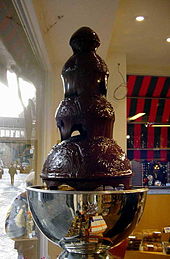 Chocolate is made with high levels of cocoa butter, allowing it to flow gently over a chocolate fountain to serve as dessert fondue.
Chocolate is made with high levels of cocoa butter, allowing it to flow gently over a chocolate fountain to serve as dessert fondue.
- Dark chocolate: sugar, cocoa butter, cocoa liquor, and (sometimes) vanilla
- Milk chocolate: sugar, cocoa butter, cocoa liquor, milk or milk powder, and vanilla
- White chocolate: sugar, cocoa butter, milk or milk powder, and vanilla
Usually, an emulsifying agent, such as soy lecithin, is added, though a few manufacturers prefer to exclude this ingredient for purity reasons and to remain GMO-free, sometimes at the cost of a perfectly smooth texture. Some manufacturers are now using PGPR, an artificial emulsifier derived from castor oil that allows them to reduce the amount of cocoa butter while maintaining the same mouthfeel.
The texture is also heavily influenced by processing, specifically conching (see below). The more expensive chocolate tends to be processed longer and thus have a smoother texture and mouthfeel, regardless of whether emulsifying agents are added.
Different manufacturers develop their own "signature" blends based on the above formulas, but varying proportions of the different constituents are used. The finest, plain dark chocolate couvertures contain at least 70% cocoa (both solids and butter), whereas milk chocolate usually contains up to 50%. High-quality white chocolate couvertures contain only about 35% cocoa.
Producers of high quality, small batch chocolate argue that mass production produces bad quality chocolate.[47] Some mass-produced chocolate contains much less cocoa (as low as 7% in many cases), and fats other than cocoa butter. Vegetable oils and artificial vanilla flavor are often used in cheaper chocolate to mask poorly fermented and/or roasted beans.[47]
In 2007, the Chocolate Manufacturers Association in the United States, whose members include Hershey, Nestlé, and Archer Daniels Midland, lobbied the Food and Drug Administration to change the legal definition of chocolate to let them substitute partially hydrogenated vegetable oils for cocoa butter, in addition to using artificial sweeteners and milk substitutes.[55] Currently, the U.S. Food and Drug Administration (FDA) does not allow a product to be referred to as "chocolate" if the product contains any of these ingredients.[56][57]
Conching
Main article: ConchingThe penultimate process is called conching. A conche is a container filled with metal beads, which act as grinders. The refined and blended chocolate mass is kept in a liquid state by frictional heat. Chocolate prior to conching has an uneven and gritty texture. The conching process produces cocoa and sugar particles smaller than the tongue can detect, hence the smooth feel in the mouth. The length of the conching process determines the final smoothness and quality of the chocolate. High-quality chocolate is conched for about 72 hours, lesser grades about four to six hours. After the process is complete, the chocolate mass is stored in tanks heated to approximately 45–50 °C (113–122 °F) until final processing.[58]
Tempering
The final process is called tempering. Uncontrolled crystallization of cocoa butter typically results in crystals of varying size, some or all large enough to be clearly seen with the naked eye. This causes the surface of the chocolate to appear mottled and matte, and causes the chocolate to crumble rather than snap when broken.[59] The uniform sheen and crisp bite of properly processed chocolate are the result of consistently small cocoa butter crystals produced by the tempering process.
The fats in cocoa butter can crystallize in six different forms (polymorphous crystallization).[59] The primary purpose of tempering is to assure that only the best form is present. The six different crystal forms have different properties.
Crystal Melting temp. Notes I 17 °C (63 °F) Soft, crumbly, melts too easily II 21 °C (70 °F) Soft, crumbly, melts too easily III 26 °C (79 °F) Firm, poor snap, melts too easily IV 28 °C (82 °F) Firm, good snap, melts too easily V 34 °C (93 °F) Glossy, firm, best snap, melts near body temperature (37°C) VI 36 °C (97 °F) Hard, takes weeks to form Making chocolate considered "good" is about forming as many type V crystals as possible. This provides the best appearance and texture and creates the most stable crystals, so the texture and appearance will not degrade over time. To accomplish this, the temperature is carefully manipulated during the crystallization.
Generally, the chocolate is first heated to 45 °C (113 °F) to melt all six forms of crystals.[59] Next, the chocolate is cooled to about 27 °C (81 °F), which will allow crystal types IV and V to form. At this temperature, the chocolate is agitated to create many small crystal "seeds" which will serve as nuclei to create small crystals in the chocolate. The chocolate is then heated to about 31 °C (88 °F) to eliminate any type IV crystals, leaving just type V. After this point, any excessive heating of the chocolate will destroy the temper and this process will have to be repeated. However, there are other methods of chocolate tempering used. The most common variant is introducing already tempered, solid "seed" chocolate. The temper of chocolate can be measured with a chocolate temper meter to ensure accuracy and consistency. A sample cup is filled with the chocolate and placed in the unit which then displays or prints the results.
Two classic ways of manually tempering chocolate are:
- Working the molten chocolate on a heat-absorbing surface, such as a stone slab, until thickening indicates the presence of sufficient crystal "seeds"; the chocolate is then gently warmed to working temperature.
- Stirring solid chocolate into molten chocolate to "inoculate" the liquid chocolate with crystals (this method uses the already formed crystals of the solid chocolate to "seed" the molten chocolate).
Chocolate tempering machines (or temperers) with computer controls can be used for producing consistently tempered chocolate, particularly for large volume applications.
Storage
Chocolate is very sensitive to temperature and humidity. Ideal storage temperatures are between 15 and 17 °C (59 and 63 °F), with a relative humidity of less than 50%. Chocolate is generally stored away from other foods, as it can absorb different aromas. Ideally, chocolates are packed or wrapped, and placed in proper storage with the correct humidity and temperature. Additionally, chocolate is frequently stored in a dark place or protected from light by wrapping paper. Various types of "blooming" effects can occur if chocolate is stored or served improperly. If refrigerated or frozen without containment, chocolate can absorb enough moisture to cause a whitish discoloration, the result of fat or sugar crystals rising to the surface. Moving chocolate from one temperature extreme to another, such as from a refrigerator on a hot day, can result in an oily texture. Although visually unappealing, chocolate suffering from bloom is perfectly safe for consumption.[60][61][62]
Potential health effects
Main article: Health effects of chocolateEven though chocolate is regularly eaten for pleasure, there are potentially a lot of health effects, both negative and positive. Cocoa or dark chocolate may positively affect the circulatory system.[63] Other possible effects under basic research include anticancer, brain stimulator, cough preventor and antidiarrhoeal activities.[64] An aphrodisiac effect is yet unproven.
According to research, limited amounts of dark chocolate appear to help prevent heart disease. The oxidation of LDL cholesterol is considered a major factor in the promotion of coronary disease. When this waxy substance oxidizes, it tends to stick to artery walls, increasing the risk of a heart attack or stroke. Research has shown the polyphenols in chocolate inhibit oxidation of LDL cholesterol.[65]
On the other hand, the unconstrained consumption of large quantities of any energy-rich food, such as chocolate, without a corresponding increase in activity, is thought to increase the risk of obesity. Raw chocolate is high in cocoa butter, a fat which is removed during chocolate refining, then added back in in varying proportions during the manufacturing process. Manufacturers may add other fats, sugars, and milk as well, all of which increase the caloric content of chocolate.
Chocolate absorbs lead from the environment during production, and there is a slight concern of mild lead poisoning for some types of chocolate. The average lead concentration of cocoa beans was a very low ≤ 0.5 ng/g, one of the lowest reported values for a natural food. Lead concentration of chocolate was as high as 70 ng/g for chocolate products and 230 ng/g for manufactured cocoa.[66] 200,000 ng is the WHO tolerable daily limit for lead consumption.[67] Additionally, chocolate is toxic to many animals because of insufficient capacity to metabolize theobromine.[2]
A BBC report indicated that melting chocolate in one's mouth produced an increase in brain activity and heart rate that was more intense than that associated with passionate kissing, and also lasted four times as long after the activity had ended.[68]
In later research, chocolate has been linked with multiple health benefits and liabilities. Research on elderly people showed chocolate might cause osteoporosis.[69] However, more research has shown that it will boost cognitive abilities.[70] Further, dark chocolate and cocoa butter have been linked with multiple positive effects. Scientific evidence has suggested dark chocolate can help reduce the risk of cardiovascular problems [71] and also reduce blood pressure in both overweight and normal adults.[71] Finally, studies have shown dark chocolate as part of a low-fat diet can lower cholesterol levels in adults.[72]
In August 2011, Cambridge research published in the British Medical Journal: Eating high levels of chocolate could be associated with a significant reduction in the risk of certain cardiovascular disorders.[73]
Labelling
Some manufacturers provide the percentage of chocolate in a finished chocolate confection as a label quoting percentage of "cocoa" or "cacao". It should be noted that this refers to the combined percentage of both cocoa solids and cocoa butter in the bar, not just the percentage of cocoa solids.[74]
Chocolates that are organic[75] or fair trade certified[76] carry labels accordingly.
In the United States, some large chocolate manufacturers lobbied the federal government to permit confections containing cheaper hydrogenated vegetable oil in place of cocoa butter to be sold as "chocolate". In June 2007, as a response to consumer concern after the proposed change, the FDA reiterated "Cacao fat, as one of the signature characteristics of the product, will remain a principal component of standardized chocolate."[77]
Manufacturers
Many chocolate manufacturers have created products from chocolate bars to fudge, hoping to attract more consumers with each creation. Both The Hershey Company and Mars have become the largest manufacturers in the world.[citation needed] Other significant players include Nestlé, Kraft Foods and Lindt.
The Hershey Company, known for their Hershey bar, Hershey's Kisses and Reese's Peanut Butter Cups, is the largest chocolate manufacturer in North America.[78] Mars, Incorporated, one of the largest privately owned U.S. corporations, is a worldwide manufacturer of confectionery and other food products, with US$21 billion in annual sales in 2006. Mars is known for Mars Bar, Milky Way, M&M's, Twix and Snickers, as well as other confectionery items, such Skittles.
Food conglomerates Nestlé SA and Kraft Foods both have chocolate brands. Nestlé acquired Rowntree's in 1988 and now market chocolates under their own brand, including Smarties and Kit Kat; Kraft Foods through its 1990 acquisition of Jacobs Suchard, now own Milka and Suchard. In February 2010, Kraft also acquired British-based Cadbury plc, the world's largest confectionery manufacturer.[79] Cadbury is well known for its Dairy Milk range and Creme Egg; Fry's, Trebor Basset, the fair-trade brand Green & Black's also belong to the group.
The chocolate industry, a steadily growing, $50 billion-a-year worldwide business centered on the sale and consumption of chocolate, is prevalent on five out of seven continents.[80] Big Chocolate, as it is also called, is essentially an oligopoly between major international chocolate companies in Europe and the U.S. These U.S. companies, such as Mars and Hershey’s alone, generate $13 billion a year in chocolate sales and account for two-thirds of U.S. manufacturers.[81] However, Europe accounts for 45% of the world's chocolate revenue.[82]
In popular culture
Holidays
Chocolate is one of the most popular holiday gifts. On Valentine's Day, a box of chocolates is traditional, usually presented with flowers and a greeting card. It may be gifted on other holidays, including Christmas, Easter, Thanksgiving, and birthdays. At Easter, chocolate eggs are traditional. This is a confectionery made primarily of chocolate, and can either be solid, hollow, or filled with other sweets or fondant.
Books and film
Chocolate has been the center of several successful book and film adaptations. In 1964, Roald Dahl published a children's novel titled Charlie and the Chocolate Factory. The novel centers on a poor boy named Charlie Bucket who takes a tour through the greatest chocolate factory in the world, owned by Willy Wonka. Two film adaptations of the novel were produced. The first was Willy Wonka & the Chocolate Factory, a 1971 film which later became a cult classic. Thirty-four years later, a second film adaptation was produced, titled Charlie and the Chocolate Factory. The 2005 film was very well received by critics[83] and was one of the highest grossing films that year, earning over US$470,000,000 worldwide.[84] Charlie and the Chocolate Factory was also recognized at the 78th Academy Awards, where it was nominated for Best Costume Design for Gabriella Pesucci.[85]
Like Water for Chocolate (Como agua para chocolate), a 1989 love story by novelist Laura Esquivel, was adapted to film in 1992. The plot incorporates magical realism with Mexican cuisine, and the title is a double entendre in its native language, referring both to a recipe for hot chocolate and to an idiom that is a metaphor for sexual arousal. The film earned 11 Ariel Awards from the Academia Mexicana de Artes y Ciencias Cinematográficas, including Best Picture.
Chocolat, a 1999 novel by Joanne Harris, tells the story of Vianne Rocher, a young mother, whose confections change the lives of the townspeople. The 2000 film adaptation, Chocolat, also proved successful, grossing over US$150,000,000 worldwide,[86] and receiving Academy Award and Golden Globe nominations for Best Picture, Best Actress, and Best Original Score.[87][88]
Chocolate also features in a large number of other literary works, often in a role central to the plot such as JoAnna Carl's Chocoholic Mysteries series and Toby Moore's Death by Chocolate.
See also
- Candida krusei
- Chocolate chip
- Cocoa (disambiguation)
- The chocolate game
- United States military chocolate
- Adelbert Bucher, Chocolatier
Notes
- ^ Taubert, Dirk; Renate Roesen, Clara Lehmann, Norma Jung, Edgar Schömig (4 July 2007). "Effects of Low Habitual Cocoa Intake on Blood Pressure and Bioactive Nitric Oxide". The Journal of the American Medical Association 298 (1): 49–60. doi:10.1001/jama.298.1.49. PMID 17609490. http://jama.ama-assn.org/cgi/content/abstract/298/1/49. Retrieved 12 January 2010.
- ^ a b c "Veterinary Q & A: Chocolate Toxicity". About.com. http://vetmedicine.about.com/cs/nutritiondogs/a/chocolatetoxici.htm. Retrieved 20 May 2008.
- ^ Justin Kerr. "Chocolate: A Mesoamerican Luxury 1200—1521 - Obtaining Cacao". Field Museum. http://www.fieldmuseum.org/Chocolate/history_mesoamerican7.html. Retrieved 2008-06-02.
- ^ a b "The American Heritage Dictionary". Archived from the original on 2008-05-17. http://web.archive.org/web/20080517202741/http://www.bartleby.com/61/68/C0316800.html. Retrieved 9 May 2009.
- ^ Campbell, Lyle. Quichean Linguistic Prehistory; University of California Publications in Linguistics No. 81. Berkeley, California: University of California Press. p. 104.
- ^ Santamaria, Francisco. Diccionario de Mejicanismos. Mexico: Editorial Porrúa S. A.. pp. 412–413.
- ^ a b Coe, Michael D.; Coe, Sophie D. (1996). The True History of Chocolate. London: Thames & Hudson, Ltd.. pp. 115–121. ISBN 0-500-28229-3.
- ^ Dakin, Karen; Wichmann, Søren (2000). "Cacao and Chocolate: A Uto-Aztecan perspective". Ancient Mesoamerica 11: 55–75. doi:10.1017/S0956536100111058.
- ^ a b "New Chemical Analyses Take Confirmation Back 500 Years and Reveal that the Impetus for Cacao Cultivation was an Alcoholic Beverage". Penn Museum. Archived from the original on 2007-12-02. http://web.archive.org/web/20071202095415/http://www.museum.upenn.edu/new/news/fullrelease.php?which=306. Retrieved 13 November 2007.
- ^ "Chocolate: A Mesoamerican Luxury 250-900 C.E. (A.D.) - Obtaining Cacao". Field Museum. http://www.fieldmuseum.org/Chocolate/history_mesoamerican3.html. Retrieved 2 June 2008.
- ^ "Chocolate: A Mesoamerican Luxury 250-900 C.E. (A.D.) - Making Chocolate". Field Museum. http://www.fieldmuseum.org/Chocolate/history_mesoamerican4.html. Retrieved 2 June 2008.
- ^ "Chocolate: A Mesoamerican Luxury 250-900 C.E. (A.D.) Using Chocolate". Field Museum. http://www.fieldmuseum.org/Chocolate/history_mesoamerican5.html. Retrieved 2 June 2008.
- ^ Kemsley, Jyllian (2008). "Cacao Drinks Date To 1150 B.C.". American Chemical Society. http://pubs.acs.org/cen/news/85/i47/8547news3.html. Retrieved 2008-07-12.
- ^ a b c d Burleigh, Robert (2002). Chocolate: Riches from the Rainforest. Harry N. Abrams, Ins., Publishers. ISBN 0-8109-5734-5.
- ^ Earley, Diane (2001). The Official M&M's History of Chocolate. Charlesbridge Publishing. ISBN 1-57091-448-6.
- ^ a b "Etymology of the word chocolate". Chocolate.be. 2008. http://www.chocolate.be/eng/history/history.htm. Retrieved 2008-06-27.
- ^ Peniche Rivero, Piedad (1990). "When cocoa was used as currency - pre-Columbian America - The Fortunes of Money". UNESCO Courier. http://findarticles.com/p/articles/mi_m1310/is_1990_Jan/ai_8560999. Retrieved 2008-06-26.
- ^ Buford, Bill. "Notes of a Gastronome: Extreme Chocolate: Reporting & Essays: The New Yorker". The New Yorker. http://www.newyorker.com/reporting/2007/10/29/071029fa_fact_buford. Retrieved 17 May 2008.
- ^ "Dark chocolate helps diarrhea". Children's Hospital & Research Center at Oakland. http://www.eurekalert.org/pub_releases/2005-09/chr-dch092905.php. Retrieved 2 May 2007.
- ^ "Chocolate: A Mesoamerican Luxury 1200—1521 - Obtaining Cacao". Field Museum. http://www.fmnh.org/Chocolate/history_mesoamerican7.html. Retrieved 14 June 2011.
- ^ Solís y Ribadeneyra, Antonio de (1685 original [1724 trans.]). "Book III Chapter XV" (in original in Spanish). The History of the Conquest of Mexico by the Spaniards, done into English by Thomas Townsend. Trans. Thomas Townsend. London. pp. 336–38.
- ^ History of Chocolate
- ^ Hickling, William (1838). History of the Conquest of Mexico. ISBN 0-375-75803-8.
- ^ Stradley, Linda (2004). "Rediscover True Hot Chocolate - History of Hot Chocolate". Linda Stradley. http://whatscookingamerica.net/Beverage/HotChocolate.htm. Retrieved 2008-06-27.
- ^ a b "Chocolate: A European Sweet". Field Museum. http://www.fieldmuseum.org/Chocolate/history_european.html. Retrieved 2 June 2008.
- ^ "Chocolate: A European Sweet - 1521—1600 - Obtaining Cacao". Field Museum. http://www.fieldmuseum.org/Chocolate/history_european3.html. Retrieved 2 June 2008.
- ^ "Chocolate: A European Sweet 1521–1600 - Using Chocolate". Field Museum. http://www.fieldmuseum.org/Chocolate/history_european5.html. Retrieved 2 June 2008.
- ^ "Chocolate: A European Sweet - 1600–1750 - Obtaining Cacao". Field Museum. http://www.fieldmuseum.org/Chocolate/history_european8.html. Retrieved 2 June 2008.
- ^ a b "Chocolate: A European Sweet - 1600–1750 - Using Chocolate". Field Museum. http://www.fieldmuseum.org/Chocolate/history_european10.html. Retrieved 2 June 2008.
- ^ "About Hans Sloane". Natural History Museum. http://www.nhm.ac.uk/research-curation/projects/sloane-herbarium/hanssloane.htm. Retrieved 8 June 2007.
- ^ "Chocolate: A Contemporary Confection 1750—1910 - Making Chocolate". Field Museum. http://www.fieldmuseum.org/Chocolate/history_contemp4.html. Retrieved 2 June 2008.
- ^ "Chocolate: A Contemporary Confection 1750—1910 - Using Chocolate". Field Museum. http://www.fieldmuseum.org/Chocolate/history_contemp5.html. Retrieved 2 June 2008.
- ^ "Chocolate: A Contemporary Confection 1910—Today - Today's Global Treat". Field Museum. http://www.fieldmuseum.org/Chocolate/history_contemp6.html. Retrieved 2 June 2008.
- ^ a b "Directive 2000/36/EC of the European Parliament and of the Council of 23 June 2000 relating to cocoa and chocolate products intended for human consumption". Publications Office of the European Union. http://eur-lex.europa.eu/LexUriServ/LexUriServ.do?uri=CELEX:32000L0036:EN:NOT. Retrieved 31 October 2010.
- ^ "US Federal Register – White Chocolate; Establishment of a Standard of Identity". U.S. Food and Drug Administration. Archived from the original on 2008-03-21. http://web.archive.org/web/20080321150727/http://www.cfsan.fda.gov/~lrd/fr021004.html. Retrieved 1 June 2008.
- ^ Ross, Emma (30 August 2004). "Dark Chocolate Could Help Hearts". CBS News. http://www.cbsnews.com/stories/2004/08/30/health/main639325.shtml. Retrieved 29 May 2008.
- ^ http://books.google.com/books?id=hEkOVtE1SCIC&pg=PT95&dq=raw+cacao&hl=en&ei=3S6fTaqsDOjYiALH7vT8Ag&sa=X&oi=book_result&ct=result&resnum=1&ved=0CEYQ6AEwAA#v=onepage&q=raw%20cacao&f=false
- ^ Ariyoshi, Rita. "The Rarest Chocolate in the World - Surprise: It’s made in Hawai‘i". Spirit of Aloha. Archived from the original on 2007-10-18. http://web.archive.org/web/20071018033010/http://www.spiritofaloha.com/features/0907/rarest.html. Retrieved 2 May 2007.
- ^ "Africa | Meeting the 'chocolate slaves'". BBC News. 13 June 2002. http://news.bbc.co.uk/2/hi/africa/2042474.stm. Retrieved 22 January 2010.
- ^ "Chocolate and Slavery". .american.edu. http://www1.american.edu/ted/chocolate-slave.htm. Retrieved 22 January 2010.
- ^ a b Bridges, Andrew. "Sides square off in chocolate fight". Pantagraph. http://www.pantagraph.com/articles/2007/08/07/money/doc46b877b718f6e292646985.txt. Retrieved 17 May 2008.
- ^ Dillon, Sheila (23 December 2007). "The Food Programme" (Real Audio). BBC Radio 4. http://www.bbc.co.uk/radio4/factual/foodprogramme_20071223.shtml.
- ^ "Chocolate industry avoids collapse as genome published". BBC. 14 November 2010. http://www.bbc.co.uk/news/science-environment-11747616. Retrieved 15 November 2010.
- ^ "What's Noka Worth? An investigation in high-priced chocolate". Dallas Food. Archived from the original on 13 June 2007. http://web.archive.org/web/20070613055736/http://www.dallasfood.org/modules.php?name=News&file=article&sid=78. Retrieved 31 December 2006.
- ^ "Cacao". Botanica.com. 1995-2008. http://www.botanical.com/botanical/mgmh/c/cacao-02.html. Retrieved 2008-06-27.
- ^ "All About Chocolate: The Cacao Tree". Xocoatl. http://www.xocoatl.org/tree.htm. Retrieved 20 December 2007.
- ^ a b c d e f Kowalchuk, Kristine. "Cuckoo for Cocoa". Westworld Alberta. http://www.ama.ab.ca/cps/rde/xchg/ama/web/membership_WWarticle-Feb08-UpFront-10192.htm. Retrieved 1 February 2008.
- ^ "Criollo Chocolate: Efficient Food of the Gods". MetaEfficient. http://www.metaefficient.com/food-and-drink/criollo-chocolate-efficient-food-of-the-gods.html. Retrieved 17 May 2008.
- ^ "Sensational Chocolates: Discover the Intense Robust flavor of 100% "Grand Cru" Chocolate". Sensational Chocolates. Archived from the original on 2008-03-28. http://web.archive.org/web/20080328013647/http://www.sensationalchocolates.com/ingredients.html. Retrieved 17 May 2008.
- ^ "What are the varieties of cocoa?". International Cocoa Organization. 21 July 1998. Archived from the original on 18 February 2006. http://web.archive.org/web/20060218083848/http://www.icco.org/questions/varieties.htm. Retrieved 27 June 2006.
- ^ Schwan, R.; Wheals, A. (2004). "The Microbiology of Cocoa Fermentation and its Role in Chocolate Quality". Critical Reviews in Food Science and Nutrition 44 (4): 205–221. doi:10.1080/10408690490464104. PMID 15462126.
- ^ "Harvesting the seeds". Xocoatl. http://www.xocoatl.org/harvest.htm. Retrieved 20 May 2008.
- ^ "Making Chocolate from Scratch". http://api.ning.com/files/Gr6vd-Aqjs2vj5t4p5tX-cZBB1kpTzKVDk8I59vVV6*FgB5zFYsVooD0wRRlQHO8tNMURHMwKR5hmuPX2Pe3al3iWOhcsi5S/Makingchocolatefromscratch.pdf. Retrieved 2 August 2011.
- ^ "At the chocolate factory". The Cocoa Tree. http://www.cocoatree.org/frombeantobar/atthechocolatefactory.asp. Retrieved 20 May 2008.
- ^ Bragg, Lynn (2007). "Letter to CMA from President (pdf)" (PDF). Archived from the original on 2007-06-04. http://web.archive.org/web/20070604203647/http://www.chocolateusa.org/pdfs/CMA-stakeholder.pdf. Retrieved 8 June 2007.
- ^ "Adopt Regulations of General Applicability to all Food Standards that would Permit, within Stated Boundaries, Deviations from the Requirements of the Individual Food Standards of Identity". U.S. Food and Drug Administration. http://www.fda.gov/ohrms/dockets/dockets/07p0085/07p-0085.htm. Retrieved 9 June 2007.
- ^ "2007P-0085 Appendix C Changes Allowed to Modernize Food Standards While Retaining The Basic Nature and Essential Characteristics of Standardized Food" (PDF). U.S. Food and Drug Administration. http://www.typetive.com/blogimages/07p-0085AppendixC.pdf. Retrieved 9 June 2007.
- ^ Zonis, Stephanie. "Conching: Crucial Step in Chocolate’s Flavor and Texture?". Sally's Place. http://www.sallys-place.com/food/columns/zonis/conching.htm. Retrieved 20 May 2008.
- ^ a b c LaBau, Elizabeth. "How To Temper Chocolate". About.com. http://candy.about.com/od/candybasics/ht/temperchoc.htm. Retrieved 20 May 2008.
- ^ "Tips for Chocolate Care". Ghirardelli. http://www.ghirardelli.com/chocopedia/tips.aspx. Retrieved 16 April 2007.
- ^ Miller, Teresa. "Milkfat Fractions Help Beat Blooming Chocolate". College of Agricultural Life and Sciences, University of Wisconsin-Madison. Archived from the original on 2007-06-09. http://web.archive.org/web/20070609144511/http://www.cals.wisc.edu/media/news/01_97/milkfat_chocolate.html. Retrieved 16 April 2007.
- ^ "How to Store Chocolate". CocoaBella. Archived from the original on February 8, 2007. http://web.archive.org/web/20070208160345/http://www.cocoabella.com/chocolates02.php. Retrieved 16 April 2007.
- ^ DeNoon, Daniel J.. "Dark Chocolate Is Healthy Chocolate". WebMD. http://www.webmd.com/diet/news/20030827/dark-chocolate-is-healthy-chocolate. Retrieved 20 May 2008.
- ^ Ingall, Marjorie. "Chocolate can do good things for your heart, skin and brain". CNN Health. http://www.cnn.com/2006/HEALTH/12/20/health.chocolate/. Retrieved 20 May 2008.
- ^ John Robbins. "Chocolate's Startling Health Benefits". The Huffington Post. http://www.huffingtonpost.com/john-robbins/chocolates-startling-heal_b_825978.html. Retrieved February 25, 2011.
- ^ Rankin, Charley W.; Jerome O. Nriagu, Jugdeep K. Aggarwal, Toyin A. Arowolo, Kola Adebayo, A. Russell Flegal (October 2005). "Lead Contamination in Cocoa and Cocoa Products: Isotopic Evidence of Global Contamination". Environmental Health Perspectives 113 (10): 1344–8. doi:10.1289/ehp.8009. PMC 1281277. PMID 16203244. http://ehsehplp03.niehs.nih.gov/article/fetchArticle.action;jsessionid=25D68A5C0CBD618A8A8BECD7E0D69DEE?articleURI=info%3Adoi%2F10.1289%2Fehp.8009. Retrieved 7 August 2010.
- ^ "Lead Content of Soil, Plants, Foods, Air, and Chinese Herb Formulas". http://www.itmonline.org/arts/lead.htm. Retrieved 7 August 2010.
- ^ "Chocolate better than kissing". BBC News. 16 April 2007. http://news.bbc.co.uk/2/hi/health/6558775.stm.
- ^ "Chocolate consumption and bone density in older women". http://www.ajcn.org/content/87/1/175.abstract?sid=8776dd95-b0a2-4299-835f-98ed2561a48c.
- ^ "Intake of Flavonoid-Rich Wine, Tea, and Chocolate by Elderly Men and Women Is Associated with Better Cognitive Test Performance". http://jn.nutrition.org/content/139/1/120.abstract?sid=8776dd95-b0a2-4299-835f-98ed2561a48c.
- ^ a b "Blood Pressure Is Reduced and Insulin Sensitivity Increased in Glucose-Intolerant, Hypertensive Subjects after 15 Days of Consuming High-Polyphenol Dark Chocolate". http://jn.nutrition.org/content/138/9/1671.abstract?sid=8776dd95-b0a2-4299-835f-98ed2561a48c.
- ^ "Daily Consumption of a Dark Chocolate Containing Flavanols and Added Sterol Esters Affects Cardiovascular Risk Factors in a Normotensive Population with Elevated Cholesterol". http://jn.nutrition.org/content/138/4/725.abstract?sid=8776dd95-b0a2-4299-835f-98ed2561a48c.
- ^ Cambridge Research Publication British Medical Journal Full Report Published 29 August 2011
- ^ Stevens, Molly. "Sorting Out Chocolate". Taunton. http://www.taunton.com/finecooking/articles/sorting-out-chocolate.aspx. Retrieved 17 May 2008.
- ^ "National Organic Program". USDA Agricultural Marketing Service. http://www.ams.usda.gov/nop/. Retrieved 7 June 2008.
- ^ "Selling Labelled Products". Fairtrade Labelling Organizations International. http://www.fairtrade.net/334.html. Retrieved 7 June 2008.[dead link]
- ^ "FDA's Standards for High Quality Foods". Food and Drug Administration. http://www.fda.gov/consumer/updates/foodstandards061807.html. Retrieved 17 May 2008.
- ^ Duncan, Andrew. "Hershey Kisses Potential Buyers Goodbye". Book Sense. http://www.booksense.com/readup/news/archive/0919hershey.jsp. Retrieved 30 June 2006.
- ^ Jones, Sarah (9 April 2009). "U.K. Stocks Fluctuate as Mining Shares Rally; Cadbury Declines". Bloomberg. http://www.bloomberg.com/apps/news?pid=20601102&sid=a5dPcReemm4w&refer=uk. Retrieved 14 April 2009.
- ^ "About Chocolate- History". Chocolatesource.com. http://www.chocolatesource.com/history/index.asp. Retrieved 22 January 2010.
- ^ "Background". Globalexchange.org. http://www.globalexchange.org/campaigns/fairtrade/cocoa/background.html. Retrieved 22 January 2010.
- ^ "Report: The Global Market for Chocolate to 2006". The-infoshop.com. http://www.the-infoshop.com/report/dc12377_chocolate.html. Retrieved 22 January 2010.
- ^ "Charlie and the Chocolate Factory at Rotten Tomatoes". Rotten Tomatoes. http://www.rottentomatoes.com/m/charlie_and_the_chocolate_factory/. Retrieved 29 May 2008.
- ^ "Charlie and the Chocolate Factory at Box Office Mojo". Box Office Mojo. http://www.boxofficemojo.com/movies/?id=charliechocolate.htm. Retrieved 29 May 2008.
- ^ "Nominees and Winners - 78th Annual Academy Awards". Academy of Motion Picture Arts and Sciences. Archived from the original on April 8, 2008. http://web.archive.org/web/20080408052925/http://www.oscars.org/78academyawards/nomswins.html. Retrieved 7 June 2008.
- ^ "Chocolat at Box Office Mojo". Box Office Mojo. http://boxofficemojo.com/movies/?id=chocolat.htm. Retrieved 29 May 2008.
- ^ "Chocolat at the Academy Awards database". Academy of Motion Picture Arts and Sciences. http://awardsdatabase.oscars.org/ampas_awards/BasicSearch?action=searchLink&displayType=3&BSFilmID=38520. Retrieved 30 May 2008.
- ^ "Chocolat at the Golden Globes database". Hollywood Foreign Press Association. http://www.goldenglobes.org/browse/film/23848. Retrieved 30 May 2008.
Bibliography
- Coe, Sophie D.; Michael D. Coe (2000). The True History of Chocolate. Thames & Hudson.
Further reading
- Almond, Steve (2004). Candyfreak: A Journey Through the Chocolate Underbelly of America. Algonquin Books. ISBN 1-565-12421-9.
- Doutre-Roussel, Chloe (2005). The Chocolate Connoisseur. Piatkus. ISBN 1-585-42488-9.
- Lebovitz, David (2004). The Great Book of Chocolate. Ten Speed Press. ISBN 1-580-08495-8.
- McNeil, Cameron (2006). Chocolate in Mesoamerica: A Cultural History of Cacao. University of Florida Press. ISBN 0-813-02953-8.
- Off, Carol (2006). Bitter Chocolate: Investigating the Dark Side of the World's Most Seductive Sweet. Random House. ISBN 1-595-58330-0.
- Wolfe, David; Shazzie (2005). Naked Chocolate. Rawcreation. ISBN 1-556-43731-5. http://www.amazon.co.uk/dp/0954397711.
External links
- Chocolate at the Open Directory Project
- Food of the Gods A Popular Account of Cocoa – Freely downloadable 109 page ebook by Brandon Head (1903) from Project Gutenberg
- toxiccacao on www.living-foods.com
- Glossary of Chocolate Terms
 Chisholm, Hugh, ed (1911). "Chocolate". Encyclopædia Britannica (11th ed.). Cambridge University Press.
Chisholm, Hugh, ed (1911). "Chocolate". Encyclopædia Britannica (11th ed.). Cambridge University Press.- Cocoa 'vitamin' health benefits could outshine penicillin
- Schroeter H, Heiss C, Balzer J et al. (January 2006). "(-)-Epicatechin mediates beneficial effects of flavanol-rich cocoa on vascular function in humans". Proc. Natl. Acad. Sci. U.S.A. 103 (4): 1024–9. doi:10.1073/pnas.0510168103. PMC 1327732. PMID 16418281. http://www.pnas.org/cgi/pmidlookup?view=long&pmid=16418281.
Chocolate Background Outline of chocolate · History of chocolate · Health effects of chocolate · History of chocolate in Spain
Origins Varieties Chemicals See also Categories:
Wikimedia Foundation. 2010.


